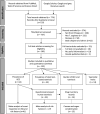Identification of risk areas and practices for Taenia saginata taeniosis/cysticercosis in Ethiopia: a systematic review and meta-analysis
- PMID: 32727549
- PMCID: PMC7391523
- DOI: 10.1186/s13071-020-04222-y
Identification of risk areas and practices for Taenia saginata taeniosis/cysticercosis in Ethiopia: a systematic review and meta-analysis
Abstract
Background: Bovine cysticercosis (BCC) is an infection of cattle with the metacestode stage of Taenia saginata, the beef tapeworm, which causes taeniosis in humans. BCC is responsible for considerable economic losses in the meat sector worldwide. This systematic review and meta-analysis summarizes the prevalence, risk factors and treatment efforts made so far on T. saginata infections in Ethiopia, providing a detailed analysis of different factors influencing the varying prevalence estimates in Ethiopia to gain more insight into the occurrence and risk factors of T. saginata taeniosis and cysticercosis to date.
Methods: A systematic review and meta-analysis was conducted on data collected from published and grey literature accessed through an electronic database and manual search.
Results: The literature search resulted in 776 outputs of which 132 conformed to the predefined criteria. The average zonal prevalence of meat inspection-based BCC ranged from 2% in Buno-Bedele to 24.6% in Sidama zone. The pooled prevalence of BCC was influenced by the number of muscle/organs inspected, ranging from 3.4% (95% CI: 1.7-5.1%) using fewer predilection sites to 19.4% (95% CI: 13.3-25.4%) using inspection of a maximum number of predilection sites. None of the tested variables were significantly associated with BCC. Questionnaire-based taeniosis ranged between 19.0% in Halaba special woreda to 70.0% in Gedeo zone and stool test-based taeniosis varied from 0.6% in central Tigray to 10.7% in Gurage zone. Questionnaire-based prevalence of taeniosis was higher in people with a frequent raw beef consumption habit (pooled OR, pOR: 10.5, 95% CI: 6.0-17.9), adults (pOR: 2.5, 95% CI: 1.7-3.6), men (pOR: 2.8, 95% CI: 2.1-3.6), and Christians (pOR: 2.0, 95% CI: 1.4-2.8) compared to less frequent raw beef consumers, younger people, women and Muslims, respectively.
Conclusions: This review revealed a widespread but variable occurrence of BCC and taeniosis in Ethiopian regions and zones, urging for harmonized and enhanced detection for improved control of the parasite. Accurate prevalence estimates using more sensitive tests, detailed risk factor analysis, as well as data on financial losses are needed to develop effective control strategies for the Ethiopian epidemiologic condition.
Keywords: Bovine cysticercosis; Ethiopia; Prevalence; Review; Risk factors; Taenia saginata; Taeniosis.
Conflict of interest statement
The authors declare that they have no competing interests.
Figures







References
-
- Torgerson PR. One world health: socioeconomic burden and parasitic disease control priorities. Vet Parasitol. 2013;195:223–232. - PubMed
-
- Allan J, Avila G, Brandr J, Correa D, Del Brutto OH, Dorny P, et al. Guidelines for the surveillance, prevention and control of taeniosis/cysticercosis. In: WHO/FAO/OIE guidelines for the surveillance, prevention and control of taeniosis/cysticercosis. Paris, France: OIE; 2005. p. 156.
-
- Dorny P, Praet N. Taenia saginata in Europe. Vet Parasitol. 2007;149:22–24. - PubMed
-
- Cabaret J, Geerts S, Madeline M, Ballandonne DBC. The use of urban sewage sludge on pastures: the cysticercosis threat. Vet Res. 2002;33:239–250. - PubMed
Publication types
MeSH terms
LinkOut - more resources
Full Text Sources

